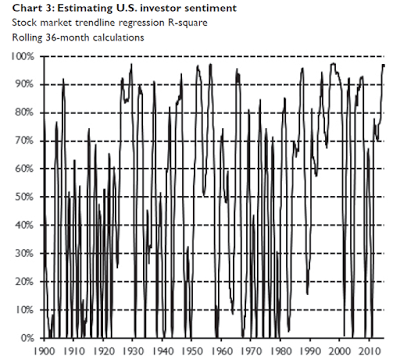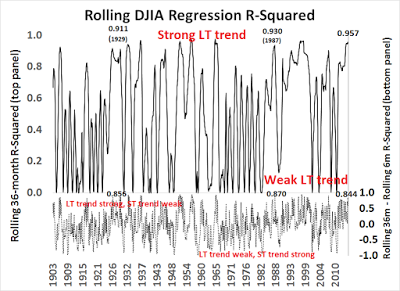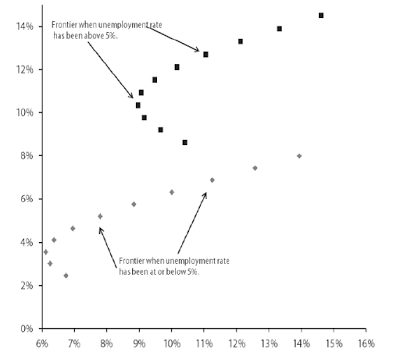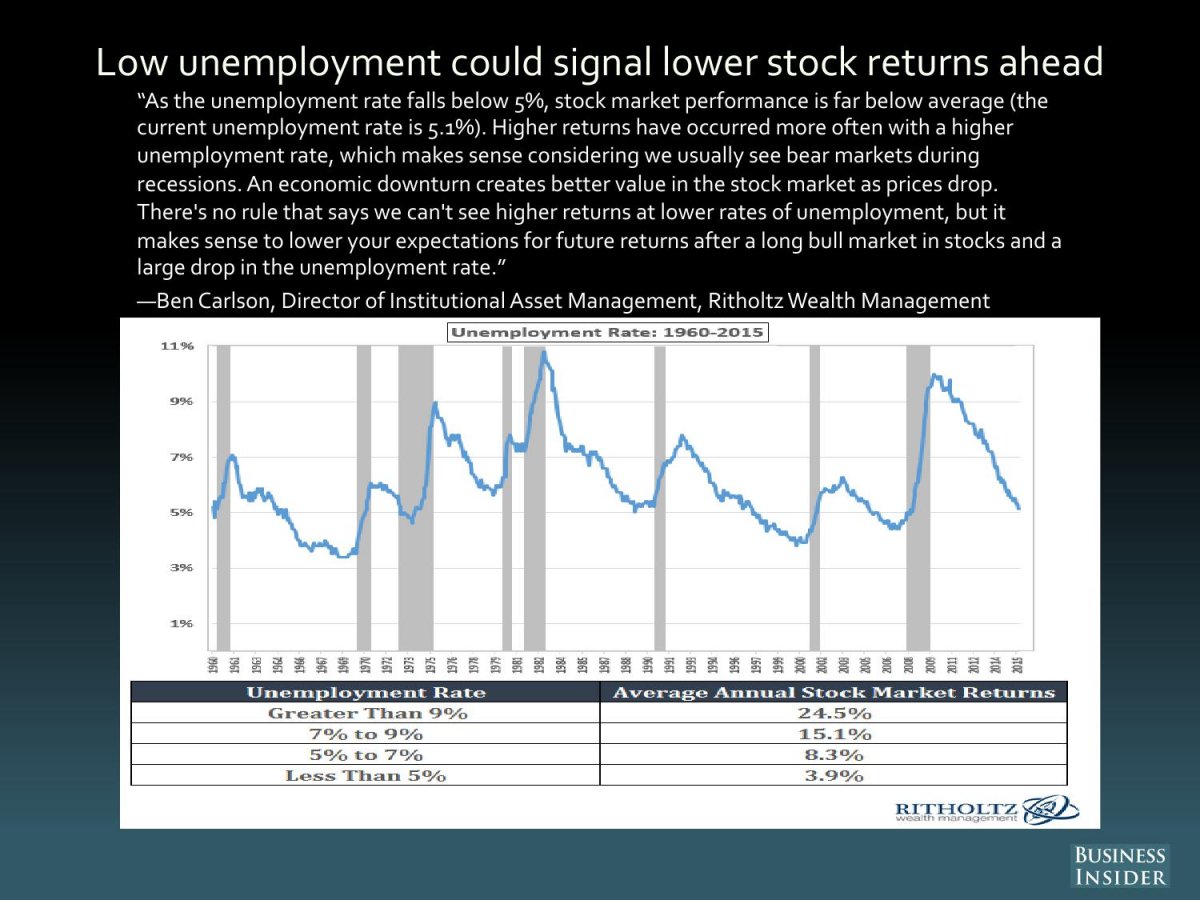I received a query from an eagle-eyed reader in response to my bullish commodity call (The weak USD scenario for equity bulls) in which I quoted Jim Paulsen's analysis on commodities. The reader questioned my bullishness (also see A "What's the credit limit on my VISA card" buy signal and Momentum = Risk on!) by pointing out that Jim Paulsen's latest essay shows that he is actually quite cautious on both stock and bonds. What gives?
To answer that question, let`s review Paulsen`s calls for 2015 to show how I have agreed or differed from his analysis.
Paulsen's 2015 record
Jim Paulsen of Wells Capital Management was spot on in his bearish call early this year. In an important April letter, he wrote that he was seeing signs of excessive complacency. He identified the current environment as market adherence to the long-term trend as overbought (my words, not his). Paulsen did the rolling 36-month regressions of stock prices and charted the R-squared of the regressions (the higher the R-squared, the tighter the fit). He found that current levels of R-squared are in the top decile of fit, which is consistent with the straight up stock market without a 10% correction that has been observed.

He interpreted these conditions as excessive complacency and suggested that stocks are due for a tumble. I expanded on Paulsen's work and found that the market has a tendency to weaken when the long-term price trend shows complacency and the short-term trend starts to roll over (see Why I am bearish (and what would change my mind)).

Explained more simply, an examination of the past 20 years shows when the monthly MACD histogram has gone negative, the stock market is either already in a corrective episode or about to weaken as illustrated by the S&P 500 monthly chart, below:
I am grateful to Jim Paulsen for that insight. In a September letter, he became more constructive on commodity prices. He believes that the recent period of commodity weakness is not a sign of impending recession, but a mid-cycle pause. In fact, falling commodity prices can provide a "second wind" boost to growth (my words, not his).
In three of the last four recoveries (i.e., the late-1970s, 1980s and 1990s recoveries), commodity prices suffered a severe decline “during an ongoing economic recovery. In each of these cases, the economic recovery persisted well beyond the bottom in commodity prices. Indeed, in the past, once commodity prices bottomed, the pace of economic growth accelerated and the recovery did not end until commodity prices had substantially recovered. For example, in the late-1970s recovery, commodity prices bottomed in July 1977 and the recovery did not end until January 1980. Similarly, commodity prices bottomed in July 1986 but the economic recovery continued until July 1990. Finally, commodity prices bottomed in early 1999 but the recovery did not peak until March 2001. As shown, a significant decline in commodity prices usually points to stronger rather than weaker future economic growth. Moreover, once commodity prices do finally bottom, they have typically risen throughout the balance of the economic recovery.
In other words, when commodity prices fall during a mid-cycle pause, ensuing economic growth spurs demand, which lifts commodities into the final peak in the economic cycle. That`s where we are today.
I would tend to agree with that analysis, with the caveat that as commodity prices are inversely correlated to the US dollar, we need to monitor the differential in monetary policy between the Federal Reserve and other major global central banks. That`s why I cautiously turned bullish on commodities.
Paulsen turns cautious
In his most recent letter, Paulsen has turned more cautious on the economic outlook, citing a US economy that is approaching full employment. Under these circumstances, stock and bond markets simply don`t behave well.
Historically, the stock and bond markets have done much better when the labor unemployment rate is above 5% (i.e., above full employment). Indeed, since 1948, annualized stock returns have been nearly twice as strong and long-term government bond returns have been almost four times greater compared to their respective returns when the unemployment rate is at or below 5%. Moreover, both stocks and bonds have tended to suffer more frequent monthly declines in fully employed economies. Finally, on average during the post-war era, once the unemployment rate reaches 5%, a recession has been less than two years away.
Here are the historical instances when the unemployment rate has been at or below 5%:

The bond market will not be a place to hide either, as the efficient frontier has historically shifted downward when unemployment falls this far.

In an earlier letter, he attributed the equity headwinds to rising wages, which puts pressure on operating margins. Even though companies may experience sales growth, earnings growth will be a more difficult task to accomplish.
Earnings performance is well past its best for this recovery and investors need to consider whether earnings growth will prove sufficient to support current stock market valuations. The rapidly aging earnings cycle is perhaps best illustrated by an economy nearing full employment with corporate profit margins near record highs. Should global growth remain tepid and overall sales results modest, since profit margins are unlikely to rise much, earnings trends will also likely prove disappointing. Conversely, should global growth and corporate sales results accelerate, because the U.S. is nearing full employment, companies may soon face cost-push pressures and margin erosion which will likely off set improved sales results.
Essentially, it is difficult to see how earnings growth will be adequate during the rest of this mature recovery to support current price/earning multiples. Is a relatively modest earnings growth against a backdrop of rising inflation and higher interest rates sufficient to support the current 18 to 19 times price/earnings multiple?
Indeed, the wage pressure issue is becoming a more prevalent as an investment theme. The latest Earnings Season update from John Butters of Factset indicates that some companies are starting to discuss this issue in their earnings calls:
A number of companies have commented on the impact of higher wages on earnings and revenues as well.
“Yeah, we don't have any plans right now for any kind of a national price increase to deal with wage pressure, but we do have a number of isolated markets, a number of which are coming up in January....We had a couple of markets that had pretty significant increases in minimum wage. Generally, we're not affected by minimum wage, but in some cases, the minimum wages are being increased to $10, $11, $12 per hour, and those will have some impact.” –Chipotle Mexican Grill ) (Oct. 20)
“Fiscal year 2017 will represent our heaviest investment period. Operating income is expected to be impacted by approximately $1.5 billion from the second phase of our previously announced investments in wages and training as well as our commitment to further developing a seamless customer experience. As a result of these investments, we expect earnings per share to decline between 6 and 12 percent in fiscal year 2017, however by fiscal year 2019 we would expect earnings per share to increase by approximately 5 to 10 percent compared to the prior year.” – Wal-Mart Stores (Oct.14)
“Looking ahead to the December quarter, we expect non-fuel CASM to be up about 2%. Expenses related to the pay increases that go into effect on December 1 are creating about a point of pressure, while international capacity reductions are also creating a temporary headwind for CASM, as the cost takeout associated with these changes comes at a lag.” – Delta Air Lines) (Oct. 13)
“Wage pressure continues to be a problem. We'll continue to monitor it as we monitor the different states and the different cities and what they're doing with minimum wage.” – Darden Restaurants) (Sep.22)
Ben Carlson also identified this problem as a headwind for equity prices (via Business Insider):

I tend to agree. In fact, I highlighted this risk in a recent post (see Margin pressures = Subdued L-T equity returns).
A matter of "sequencing"
The difference between my bullishness and Paulsen`s more cautious outlook is, as Mario Draghi is fond of saying, "Sequencing." My bullish equity call is based on a combination of friendly central bankers, powerful price momentum, positive seasonality and a mildly crowded short sentiment reading into year-end and 1Q 2016. These are conditions that are suggestive of a tradeable rally for the next 3-6 months.
Looking further into 2016, however, concerns over the aging profit cycle, wage pressures and other factors, such as Hillary Clinton`s capital gains tax proposals which would likely induce some early selling in 2016 to lock in capital gains, are going to pose headwinds for equity prices.

In conclusion, I have no major disagreements with Jim Paulsen's analysis and I continue to have enormous respect for his work. Tactically, my outlook for year-end and 2016 calls for a rally into year-end and possibly 1Q, with the SPX range-bound with an upper bound of 2200-2300 on the upside and possibly 1900-2000 on the downside.
It's all a matter of sequencing.
Disclosure: Cam Hui is a portfolio manager at Qwest Investment Fund Management Ltd. (""Qwest""). This article is prepared by Mr. Hui as an outside business activity. As such, Qwest does not review or approve materials presented herein. The opinions and any recommendations expressed in this blog are those of the author and do not reflect the opinions or recommendations of Qwest.
None of the information or opinions expressed in this blog constitutes a solicitation for the purchase or sale of any security or other instrument. Nothing in this article constitutes investment advice and any recommendations that may be contained herein have not been based upon a consideration of the investment objectives, financial situation or particular needs of any specific recipient. Any purchase or sale activity in any securities or other instrument should be based upon your own analysis and conclusions. Past performance is not indicative of future results. Either Qwest or Mr. Hui may hold or control long or short positions in the securities or instruments mentioned.

